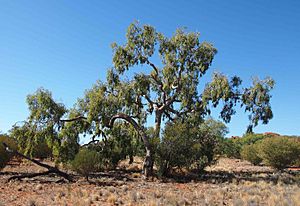Mallee bloodwood facts for kids
Quick facts for kids Mallee bloodwood |
|
|---|---|
 |
|
| Corymbia eremaea habit | |
| Scientific classification | |
| Genus: |
Corymbia
|
| Species: |
eremaea
|
| Synonyms | |
|
|
The Corymbia eremaea, also known as mallee bloodwood, hill bloodwood, or centre range bloodwood, is a special type of tree. It's usually a small tree or a mallee, which means it has many stems growing from the ground. This tree is found only in central Australia. The native people of Australia call this plant muur-muurpa.
This tree has rough bark that looks like a puzzle. Its leaves are shaped like a spear. The flower buds are oval or pear-shaped and grow on a branching stem. When the fruit appears, it looks like an urn.
Contents
What Does It Look Like?
The mallee bloodwood is usually a small tree. It can grow up to 10 m (33 ft) (about 33 feet) tall. It also has a special woody swelling at its base called a lignotuber. This helps the tree regrow if there's a fire.
Bark and Leaves
The tree's bark is rough and brownish. It covers the trunk and even the smaller branches. This rough bark looks like a pattern of small blocks, which is called "tessellated." Sometimes, smaller plants might have smooth bark.
Young mallee bloodwood plants have dull green leaves. These leaves are long and narrow, like a spear. They are about 20–110 mm (0.79–4.33 in) (0.8–4.3 inches) long and 7–21 mm (0.28–0.83 in) (0.3–0.8 inches) wide. They grow in pairs.
As the tree gets older, its leaves change. Adult leaves are also dull green and spear-shaped. They are a bit longer, about 75–120 mm (3.0–4.7 in) (3–4.7 inches) long and 10–21 mm (0.39–0.83 in) (0.4–0.8 inches) wide. Each leaf has a small stalk called a petiole, which is about 6–20 mm (0.24–0.79 in) (0.2–0.8 inches) long.
Flowers and Fruit
The flowers of the mallee bloodwood grow in groups. These groups of seven buds are found at the ends of the branches. Each group grows on a main stalk called a peduncle, which is 8–14 mm (0.31–0.55 in) (0.3–0.6 inches) long. Each individual bud has a smaller stalk called a pedicel, about 3–8 mm (0.12–0.31 in) (0.1–0.3 inches) long.
The flower buds are usually oval-shaped. They are about 6–8 mm (0.24–0.31 in) (0.2–0.3 inches) long and 4–5 mm (0.16–0.20 in) (0.16–0.2 inches) wide. Each bud has a rounded cap called an operculum.
This tree mainly flowers from November to January. Its flowers are white. After the flowers, the tree produces a woody, urn-shaped fruit. This fruit is a capsule, about 11–22 mm (0.43–0.87 in) (0.4–0.9 inches) long and 9–18 mm (0.35–0.71 in) (0.35–0.7 inches) wide. The seeds inside are brown and have a small wing, which helps them fly away in the wind.
How It Was Named
The mallee bloodwood was first officially described in 1985. Two scientists, Denis Carr and Stella Carr, gave it the name Eucalyptus eremaea. They studied samples collected near Ayers Rock in 1969.
Later, in 1995, two other botanists, Ken Hill and Lawrie Johnson, changed its name to Corymbia eremaea. They published this new name in a science journal called Telopea. The word eremaea in its name means "of the desert." This makes sense because the tree grows in desert areas.
Subspecies
There are two slightly different types, or subspecies, of C. eremaea:
- Corymbia eremaea subsp. eremaea: This type has adult leaves that are longer than 90 mm (3.5 in) (3.5 inches). Its fruits are also larger, more than 11 mm (0.43 in) (0.4 inches) across.
- Corymbia eremaea subsp. oligocarpa: This type has adult leaves shorter than 90 mm (3.5 in) (3.5 inches). Its fruits are smaller, less than 11 mm (0.43 in) (0.4 inches) across.
Where It Lives
The mallee bloodwood grows in rocky places. You can find it on stony hills, rocky slopes, and at the bottom of rocky hills. Both subspecies are very common in the dry, desert areas of central Australia. This includes the southern part of the Northern Territory, as far east as the Simpson Desert. It also grows in the northwestern part of South Australia and the Central Ranges of Western Australia.
Conservation Status
Good news! Both types of C. eremaea are doing well. The Western Australian Government's Department of Parks and Wildlife says they are "not threatened." This means they are not in danger of disappearing. The Northern Territory also lists them as being of "least concern" under their Territory Parks and Wildlife Conservation Act 1976. This means they are not at risk.

